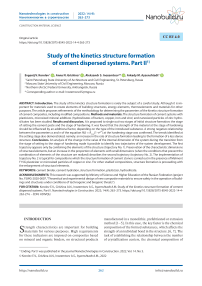Study of the kinetics structure formation of cement dispersed systems. Part II
Автор: Evgenij V. Korolev, Anna N. Grishina, Aleksandr S. Inozemtcev, Arkady M. Ayzenshtadt
Журнал: Nanotechnologies in Construction: A Scientific Internet-Journal @nanobuild-en
Рубрика: Construction materials science
Статья в выпуске: 4 Vol.14, 2022 года.
Бесплатный доступ
Introduction. The study of the kinetics structure formation is rarely the subject of a careful study. Although it is important for materials used to create elements of building structures, energy elements, thermoelements and materials for other purposes. The article proposes refinements of the methodology for determining the parameters of the kinetics structure formation of cement composites, including modified compositions. Methods and materials. The structure formation of cement systems with plasticizers, microsized mineral additives (hydrosilicates of barium, copper, iron and zinc) and nanosized particles of zinc hydrosilicates has been studied. Results and discussion. It is proposed to single out two stages of initial structure formation: the stage of setting the cement paste and the stage of hardening. It was found that the strength of the material at the stage of hardening should be influenced by an additional factor, depending on the type of the introduced substance. A strong negative relationship between the parameters α and n of the equation R(t) = Rmax(1–eatn) at the hardening stage was confirmed. The trends identified at the setting stage also demonstrated, namely: an increase in the rate of structure formation leading to the formation of a less dense structure. Conclusions. An analysis of the change in the value of the internal dimension of the system during the transition from the stage of setting to the stage of hardening made it possible to identify two trajectories of the system development. The first trajectory appears only by combining the elements of the structure (trajectory No. 1). Preservation of the characteristic dimensions of structural elements, but an increase in the proportion of elements with small dimensions (when the conditions that prevent the combination of elements of the structure are realized) describes the second trajectory (trajectory No. 2). The implementation of trajectory No. 2 is typical for compositions which the structure formation of cement stone is carried out in the presence of Melment F15G plasticizer or microsized particles of copper or zinc. For other studied compositions, structure formation is proceeding with the enlargement of structural elements.
Cement binder, cement hydration, structure formation, plasticizer, hydrosilicate
Короткий адрес: https://sciup.org/142234626
IDR: 142234626 | DOI: 10.15828/2075-8545-2022-14-4-263-273
Список литературы Study of the kinetics structure formation of cement dispersed systems. Part II
- Ahmed H, Bogas JA, Guedes M, Pereira MFC. Dispersion and reinforcement efficiency of carbon nanotubes in cementitious composites. Magazine of Concrete Research. 2018; 71(8): 408–423. Available from: https://doi.org/10.1680/jmacr.17.00562
- Aksenova VV, Alimbaev SA, Pavlov AV, Mustafin RM. Briquetting of Porous Alumina-Containing Materials Using Organic Binders. Steel in Translation. 2021; 51: 291–295. Available from: https://doi.org/10.3103/S0967091221050028
- Duong TQ, Korolev EV, Inozemtcev AS. Selection of Reinforcing Fiber for High-strength Lightweight Concrete for 3D-Printing. IOP Conference Series: Materials Science and Engineering. 2021; 1030 (1): 012007. Available from: https://doi.org/10.1088/1757-899X/1030/1/012007
- Kim M, Kim T, Kim H. Rheological analysis of physical states of cellulose nanocrystal suspension and synergetic effect of aligned gel state. Carbohydrate Polymers. 2022; 28415: 119170. Available from: https://doi.org/10.1016/j.carbpol.2022.119170
- Zhai Y, Tang Y, Li J, Duan L, Su C, Cao A, Jin C, Fang L. Structure, Raman spectra and properties of two lowεr microwave dielectric ceramics Ca3B2Ge3O12 (B = Al, Ga). Ceramics International. 2020; 46: 28710–28715. Available from: https://doi.org/10.1016/j.ceramint.2020.08.031
- Maksimova I, Makridin N, Erofeev V, Barabanov D. Study of the Properties of Water-Hardened Cement Stone Depending on the Water-Cement Ratio and Age. Proceedings of EECE 2020. 2021; 192–203. Available from: https://doi.org/10.1007/978-3-030-72404-7_20
- Maksimova IN, Erofeev VT, Makridin NI. Kinetic parameters of hydration structure formation and hardening of cement stone up to 9.5 years old after steaming. News of universities. Construction. 2018; 3: 24–33. Available from: https://elibrary.ru/item.asp?id=35250280 [Accessed 20th January 2022].
- Korolev EV, Grishina AN, Inozemtcev AS, Ayzenshtadt AM, Study of the kinetics structure formation of cement dispersed systems. Part I. Nanotechnologies in Construction. 2022; 14(3): 176–189. Available from: https://doi.org/10.15828/2075-8545-2022-14-3-176-189
- Bobryshev AN. Physics and synergetics of dispersed-disordered condensed composite systems / AN Bobryshev, VT Erofeev, VN Kozomazov. SPb.: Science; 2012.
- Bobryshev AN Strength and durability of polymer composite materials / A.N. Bobryshev, VN Kozomazov, AV Lakhno, VV Tuchkov. Lipetsk: Ulis; 2006.
- Bobryshev AN, Kozomazov VN, Avdeev RI, Tumanova NN. Topological features of kinetic processes. Condensed media and interfaces. 2003; 5: 120–125.
- Avdeev RI, Bobryshev AN, Tumanova NN. Models of evolutionary processes with linear mapping. News of the Tula State University. Series: “Technology, mechanics and durability of building materials, structures and structures. 2001; 2: 45–49.
- Voronov PV, Bobryshev AN, Lakhno AV. Estimation of the kinetics of phase transitions in hardening heterogeneous materials. Regional architecture and construction. 2010; 2: 58–66. Available from: https://elibrary.ru/item.asp?id=15322265 [Accessed 21th January 2022].
- Zhirmunsky AV. Critical levels in the development of natural systems / AV Zhirmunsky, VI Kuzmin. L.: Science; 1990.
- Grishina AN, Korolev EV. Efficiency of Modifying Cement Composites with Nanosized Barium Hydrosilicates. Building Materials. 2015; 2: 72–76. Available from: https://elibrary.ru/item.asp?id=22992326 [Accessed 22th January 2022].
- Grishina AN, Korolev EV. Choice of Technology for the Synthesis of Nanosized Barium Hydrosilicates. Nanotechnologies in construction. 2013; 5: 111–119. Available from: https://elibrary.ru/item.asp?id=20355453 [Accessed 23th January 2022].
- Grinchenko VT. A dozen lectures on fractals: From an object of admiration to a tool of knowledge / VT Grinchenko, AA Matsypura, IV Snarsky, L Vovk. M.: LENAND; 2020.


